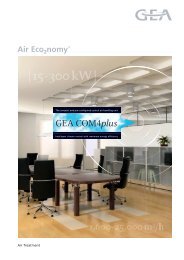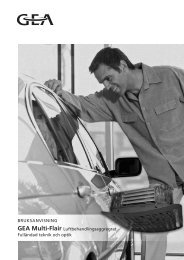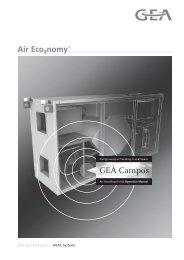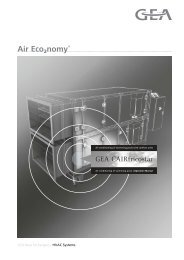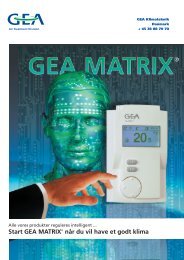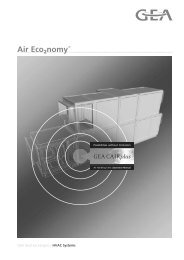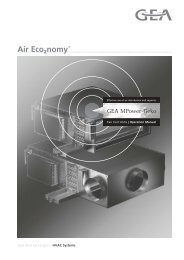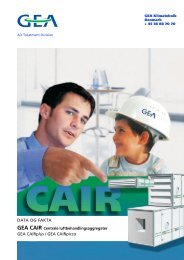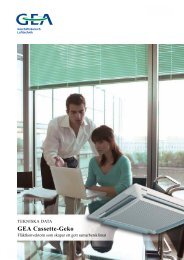GEA COM4plus - CS Klimateknik
GEA COM4plus - CS Klimateknik
GEA COM4plus - CS Klimateknik
You also want an ePaper? Increase the reach of your titles
YUMPU automatically turns print PDFs into web optimized ePapers that Google loves.
Commissioning and Testing<strong>GEA</strong> <strong>COM4plus</strong>8.7 Cooler section8.7.1 Commissioning of cooler section with/without droplet eliminatorELECTRICAL HAZARD AND DANGER OF ROTATING UNIT PARTS WITHSHARP EDGES! OBSERVE PERSONAL PROTECTION MEASURES!Please consider the safety instructions on page 41 and page 42.The following procedures for commissioning must be carried out:For droplet eliminator• Clean condensate tray and drain.• Fill trap with water, refer to „Connecting siphon (trap) and water drains“ on page 35;as a minimum requirement the water receiver for the trap must always correspondto the overpressure/low pressure of the unit.The droplet eliminator (DE) reaches its full operating limits once the separating agentvolatizes after a start-up phase amounting to around 4 weeks.• If necessary, clean the droplet eliminator by rinsing with water.• Dust with lime if necessary.In case the operating performance of the droplet eliminator is insufficient:• Ensure that the installation position of the droplet eliminator is correct:• Check the air flow velocity through the droplet eliminator.Standard DE w max =3.8 m/sDE (droplet eliminator) 100 High-performance w max =5.8 m/s8.7.2 Maintenance of cooler with/without droplet eliminatorELECTRICAL HAZARD AND DANGER OF ROTATING UNIT PARTS WITHSHARP EDGES! OBSERVE PERSONAL PROTECTION MEASURES!Please consider the safety instructions on page 41 and page 42.The following procedures for maintenance must be carried out:• Check for tightness and possible debris on the air side.• In case of frost risk check the safety devices regularly, or take appropriateprecautions such as draining the equipment or adding antifreeze agents.• Make sure that pipe connections and mountings are secure.• If necessary clean on air side (blow through heat exchanger using compressed airor low pressure water).• Provide air venting.• Clean condensate tray and drain.• Check siphon/trap, top up as necessary.• Clean droplet eliminator with descaling spray.Additional measures before cold season• Drain cooling coil before each winter if necessary. As the piping in this case has arelatively small diameter, it must always be assumed that some water remains inthe unit following normal drainage. For safety reasons, the system must also beblown through with compressed air to remove all remaining water.50 PR-2009-0022-GB • Subject to modifications • Status 04/2009




